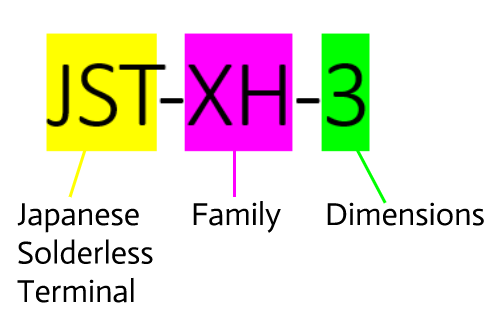JST is a standard of electrical connection used widely across a spectrum of electrical applications. It's defined as a Japanese Solderless Terminal and is manufactured by a company of the same name. The JST range includes a variety of families of connectors with varying pin to pin distances (known as pitches). The JST system was primarily designed to bridge an electrical connection or carry an electrical signal, and due to this, it is not advised to be using them for any mechanical process where the connector will be under any stresses or forces! We see them attached to batteries, motors, circuit boards and more; anything that is mounted still is fair game for this inexpensive and reliable connection type. The only issue with JST is the confusing naming scheme that often has hobbyists chasing their tails with connectors ending up .05mm too big or small for their needs. We've put together this primer on JST connectors so that you'll understand the conventions associated with these connections.
The JST connector titles are confusing; many online vendors have no idea what the standard is based around and easily mess up the ten different families. Each family has a dozen sub-categories to its name too. We want to clear the air on this naming scheme, the JST part just refers to the solderless connection type, all of the connectors share the same type of connection. The following suffix (-XH, -SH, etc.) refers to the shape/style of the connector; these families share the Pin-to-Pin Pitch but not the shape and size of the housing. To define that size, the number/letter combination past the family specification will refer to the size of the unit. If you are looking for a particular replacement part for your project, it will be pertinent for you to know the full specification you'll need. It's worth noting that each family of connectors has its own current/voltage/wire size ratings. Beware of the imperial/metric conversions too, for example, a common issue is that 2.5mm connectors not being the same as 2.54mm (.1 inch) connectors despite their often misleading titles.
There are a few guidelines that are suggested by the manufacturers when working with JST connectors; these are put in place to ensure you aren't breaking your connector or using it in an incorrect way:
- When connecting between components and board, you'll want to have a little extra cabling available so that you aren't putting additional forces onto your connector or crimp; constant pulling on the crimped wires can cause loose connections.
- JST also recommend that you only have a movement freedom of 15 degrees on each of the axes from the connector directly out along the cables, again this helps to ensure your connection will operate as expected
- You should stick to using tin-plated, annealed copper stranded wire for crimping connections between JST connectors.
- Refer to the connectors datasheet for information on the crimping tool you'll need to use for the particular family.
For more information regarding the standards by which you should use JST connectors, check out their official PDF guides:
- http://www.jst-mfg.com/precaution/eP-Crimp.pdf
- http://www.jst-mfg.com/precaution/eP-Handling.pdf
- http://www.jst-mfg.com/precaution/eP-IDC.pdf
Now you know what the connectors are, how they are specified and how to handle them we will take a look at crimping tools that we recommend you use with your JST connectors. Crimping is the act of terminating the cable, and there are specific tools available that help a lot when it comes to terminating your JST families.
 The Engineer PA-09/PA-21 Crimping Tools.
The Engineer PA-09/PA-21 Crimping Tools.
As there is such a wide variety of JST connectors available, it's a good idea to invest in a universal, multi-purpose tool that allows you to terminate any of the JST standard wires. Adafruit has provided some fantastic crimp tools that they like, and we can see why! The Engineer line of crimp tools includes both the PA-09 and PA-21 crimp tool and alongside this extremely useful comparison table, you'll easily be able to see which tool/die you need to use to correctly crimp your connectors! The manufacturers of this device have also provided a video tutorial that covers off on the important aspects of crimping connectors. There are some other crimp tools available too, so don't feel obligated in grabbing the Engineer brand.




 The Engineer PA-09/PA-21 Crimping Tools.
The Engineer PA-09/PA-21 Crimping Tools.
